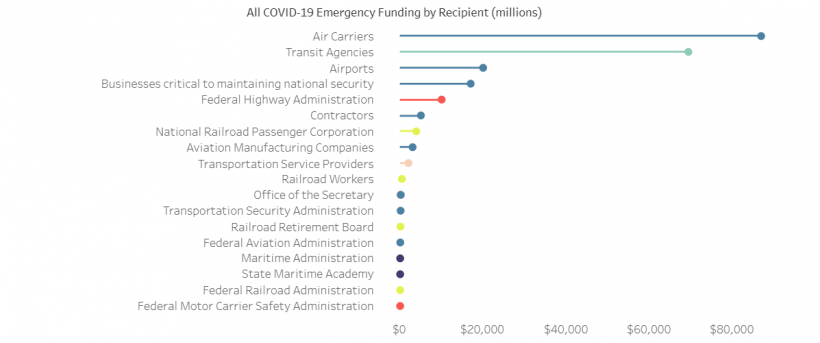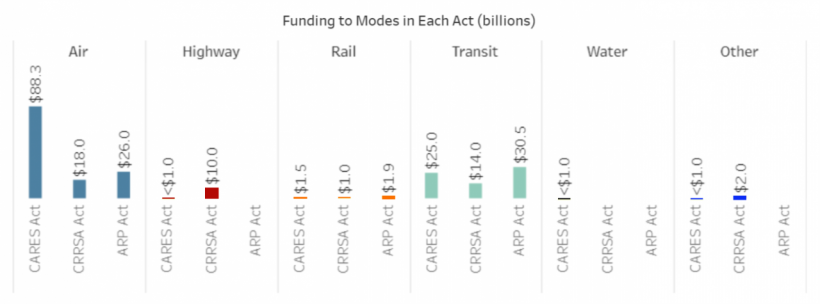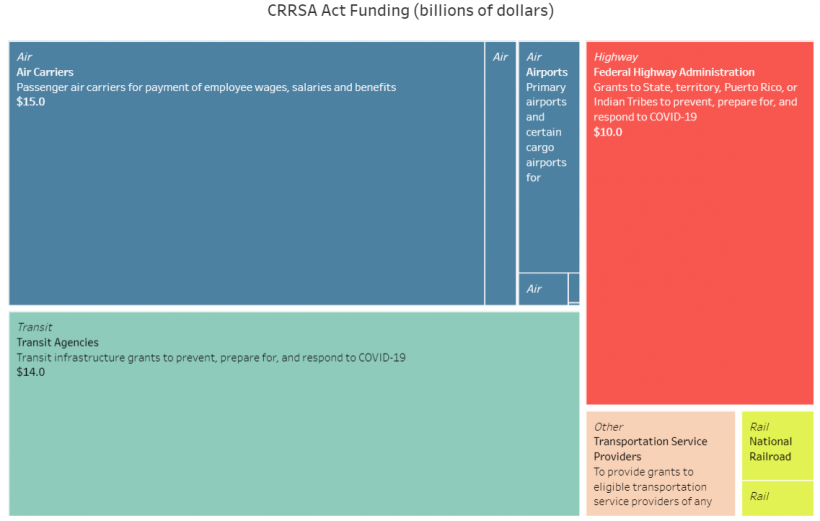Navigating the Complexities of COVID-19 Stimulus Funding for Transportation
Data spotlights represent data and statistics from a specific period of time, and do not reflect ongoing data collection. As individual spotlights are static stories, they are not subject to the Bureau of Transportation Statistics (BTS) web standards and may not be updated after their publication date. Please contact BTS to request updated information.
New BTS guide breaks it all down
The transportation industry was hit hard by the COVID-19 pandemic. The steep decline in air travel has led to persistent job loss in air transportation; in April 2021, the industry was still down 74,000 employees (15%) from pre-pandemic April 2019. Urban rail transit ridership also remains low; in April 2021, ridership was still 276 million trips lower (66%) than in April 2019, and the associated loss of fare revenue has created transit agency maintenance shortfalls. And, State and Local spending on road work was down nearly $1 billion (12%) in April 2021 from April 2019 as reduced driving in the early days of the pandemic translated into reduced State fuel tax receipts.
The U.S. Congress has passed three acts that provide relief funding for transportation. These new funding sources add complexity to the summaries of government revenues and expenditures in transportation published each year by BTS. To help track these new sources of funding, BTS has developed a guide to understanding what is being contributed to transportation by each act.

From CARES to CRSSA to ARP, the amount of funds made available for transportation varied widely.
As the above figures show, the CARES Act provided the greatest amount of funding for transportation ($114.8B) and extended to the widest variety of modes of transportation.
Aviation and Transit received the greatest proportion of funds over all three relief acts.
After “Air Carriers” and “Transit Agencies” in the chart below, the total amounts by category from the three COVID-19 relief measures drop significantly.

But, within each act, relief funds emphasized different modes.
As the chart below indicates, Air Transportation received its largest amount of funding ($88.3B) in the CARES Act and was the largest transportation beneficiary (76%) of that first COVID-19 relief measure. Highways received its largest share from the CRRSA Act, but still received less funding in CRRSA than either Air or Transit. Transit has received significant amounts from all three acts ($69.5B) and was the largest transportation beneficiary of the ARP Act (52%).

BTS COVID-19 Relief Funding for Transportation dashboard offers details by act, mode, and purpose.
Other links, charts, and graphics in the new guide, like the one shown below, provide more information to help readers make sense of the complexities of transportation relief funding in these three important measures.

Learn more!
The BTS guide offers detailed information on these three new sources of funding for transportation, the revenues from which will affect future government transportation financial statistics. The guide also provides links to further resources, including sites from FAA, FTA, and Treasury that are tracking how relief funds are being spent.
